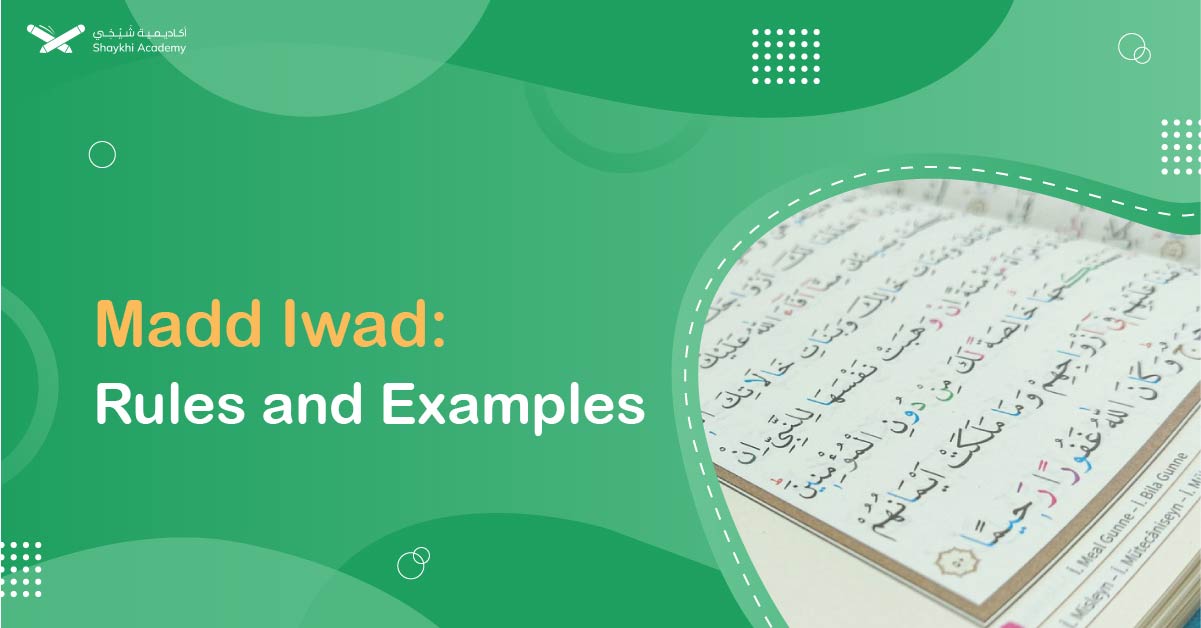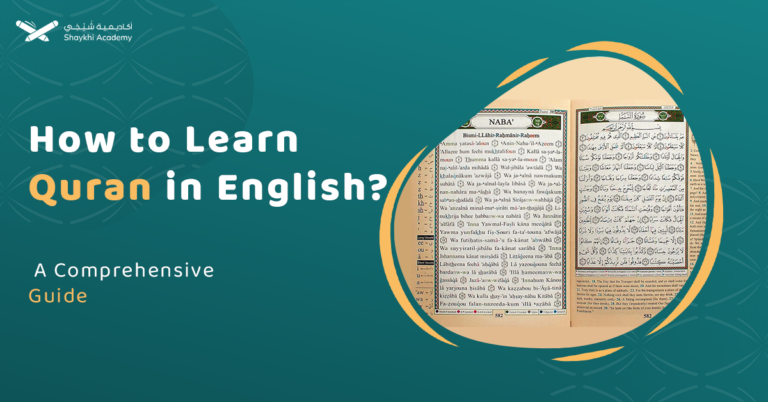In the art of Quranic recitation (Tajweed), the rules of elongation (Madd) are vital for maintaining the rhythm and beauty of the recitation. One of the significant types of Madd is Madd Iwad or Madd al-‘Iwadh. This article will explore Madd al-‘Iwadh in detail, including its definition, rules, exceptions, and various types with examples from the Quran. By understanding Madd al-‘Iwadh, you can enhance your Quranic recitation and ensure it aligns with the principles of Tajweed.
What is Madd al-‘Iwadh?
Madd al-‘Iwadh (مد العوض) is a type of natural elongation (Madd asli) in Quranic recitation. It occurs in words that end with Tanween (nunation). When a reciter stops at the end of such words, the Tanween is replaced by an elongated Alif. Essentially, Madd al-‘Iwadh involves substituting the Tanween of Nasb (Fathah with Tanween) (تنوين الفتح) with an elongated Alif when pausing.
The Importance of Madd in Tajweed
Elongation (Madd) is critical in Tajweed because it preserves the correct pronunciation and rhythm of Quranic verses. Different types of Madd, including Madd al-‘Iwadh, ensure that each word is recited with the proper intonation, contributing to the overall beauty and accuracy of the recitation.
Understanding Tanween in Arabic
Tanween is a non-vocalized “Nun” (ن) added to nouns, appearing in the nominative, genitive, and accusative cases during connected speech. When stopping, the Tanween is dropped, and the last letter is pronounced with sukoon (silence) in the nominative and genitive cases. In the accusative case, the Tanween is replaced with an Alif elongated by two counts (Harakats). This replacement is temporary and occurs only when pausing.
There are 3 main types:
1.Tanween al-Rafa’ (تنوين الرفع) – Nominative case
2.Tanween al-Kasr (تنوين الكسر) – Genitive case
3.Tanween al-Nasb (تنوين النصب) – Accusative case
When Does Madd al-‘Iwadh Occur?
- Occurrence: Madd al-‘Iwadh occurs only when stopping at the end of a word with Tanween of Nasb.
- Elongation: It is elongated by two counts (Harakats).
- Obligation: Applying Madd al-‘Iwadh is mandatory (wajib).
Exceptions to Madd al-‘Iwadh
An exception to Madd al-‘Iwadh is the feminine “Ha” (هاء التأنيث) that follows nouns with a Tanween of Nasb (fatha). When stopping on such words, the “Ha” becomes silent and is pronounced with sukoon. For example:
- شجرةً (shajaratan) becomes شجرة (shajarah)
- جنةً (jannatan) becomes جنة (jannah)
Types of Madd al-‘Iwadh:
In the Quran, there are three main types or forms of Madd al-‘Iwadh according to the script and writing style in the Mushaf:
1. Elongation Letter Retained in Script
Elongation Letter Retained in Script refers to the elongation of a specific letter in the script when stopping during Quranic recitation, indicated by dropping the Tanween and elongating the corresponding letter (like an Alif) by two counts.
Examples from holy quran:
| Example | Explanation | Surah | Ayah |
| (وَكَفَى بِاللَّـهِ وَكِيلًا)(Wa kafa billahi wakeela) | If we stop at the word (وَكِيلًا), we drop the Tanween and elongate the Alif by two counts. | Al-Ahzab | 3 |
| (وَكَانَ اللَّـهُ غَفُورًا رَّحِيمًا)(Wa kana Allahu ghafooran raheema) | If we stop at the word (رَحِيمًا), we drop the Tanween and elongate the Alif by two counts. | Al-Ahzab | 5 |
2. Elongation Letter Not Retained in Script:
Elongation Letter Not Retained in Script refers to the elongation of a specific letter in the script when stopping during Quranic recitation, indicated by dropping the Tanween and elongating the corresponding letter (like an Alif) by two counts.
Examples from holy quran:
| Example | Explanation | Surah | Ayah |
| (الَّذِي جَعَلْنَاهُ لِلنَّاسِ سَوَاءً)(Alladhi ja’alnahu linnasi sawaa) | If we stop at the word (سَوَاءً), we drop the Tanween of Nasb and pronounce it with an elongated Alif by two counts. | Al-Hajj | 25 |
| (وَأَنزَلْنَا مِنَ السَّمَاءِ مَاءً)(Wa anzalna mina assama’i maa’a) | If we stop at the word (مَاءً), we drop the Tanween of Nasb and replace it with an elongated Alif by two counts. | Al-Mu’minun | 18 |
3. Light Nun (نون التوكيد) of Emphasis Written as Tanween
Light Nun of Tawkeed نون التوكيد Written as Tanween refers to the Nun of emphasis in its written form as Tanween in the script of the Quran. When stopping at such words during recitation, the Tanween is dropped and replaced with an elongated Alif by two counts to adhere to Tajweed rules.
Examples from holy quran:
| Example | Explanation | Surah | Ayah |
| (وَلَيَكونًا مِنَ الصّاغِرينَ)(Wa layakoonan mina assaghireen) | The original form of the word (وَلَيَكونًا) is (وَلَيَكونن) with the final Nun being a Nun of emphasis. It is written as Tanween in the script. If we stop at the word (لَيَكونًا), we drop the Tanween and replace it with an elongated Alif by two counts. | Yusuf | 32 |
| (كَلَّا لَئِن لَّمْ يَنتَهِ لَنَسْفَعًا بِالنَّاصِيَةِ)(Kalla la’in lam yantahi lanasfa’an bin-nasiyah) | If we stop at the word (لَنَسْفَعًا), we drop the Tanween and replace it with an elongated Alif by two counts. | Al-Alaq | 15 |
Common Mistakes to Avoid
- Skipping the Elongation: Ensure you elongate the Alif for two counts; skipping this changes the word’s pronunciation.
- Applying Madd al-‘Iwadh Incorrectly: Only apply Madd al-‘Iwadh at the end of words with Tanween of Nasb.
Best Practices To Master Madd al-Iwad
- Practice Regularly: Consistent practice helps reinforce the rule.
- Listen to Expert Recitations: Listening to experienced reciters can help you understand the proper application of Madd al-‘Iwadh.
Interactive Learning Tools
Books and Resources
- Tajweed Textbooks: Comprehensive books on Tajweed rules.
- Audio Guides: Recordings of Quranic recitations with detailed explanations.
Online Tajweed Tools
- Interactive Tajweed Apps: Apps that provide visual and audio guides for applying Madd al-‘Iwadh.
- Online Tajweed Classes: Platforms offering live classes and recorded lessons on Tajweed.
Learn Tajweed with Shaikhy Academy
At Sheikh Academy, we offer comprehensive courses on Tajweed rules and Quranic recitation, taught by experienced instructors. Our online classes are designed to be accessible from anywhere, catering to various age groups and skill levels. Join us to master the beautiful art of Tajweed and recite the Quran with precision and confidence.
Why Choose Shaikhy Academy?
- Expert Instructors: Our courses are taught by qualified and experienced instructors who are passionate about Tajweed.
- Flexible Learning: Our online classes offer flexibility, allowing you to learn at your own pace and schedule.
- Tailored Programs: We provide customized programs to meet the needs of different age groups and skill levels.
- Comprehensive Curriculum: Our curriculum covers all aspects of Tajweed, from basic to advanced levels.
Conclusion
Understanding and applying Madd al-‘Iwadh is essential for proper Quranic recitation. It involves replacing the Tanween (either Nasb or Fathah) in a word with an elongated Alif when pausing, extending it by two counts.
By mastering this rule, you enhance the beauty and accuracy of your recitation. To further your knowledge and skills, consider enrolling in Tajweed lessons at Sheikh Academy.
Embark on your journey to perfect Quranic recitation, and may Allah grant us all the ability to recite His words beautifully and correctly. May the Quran be our means to His pleasure and blessings.













































